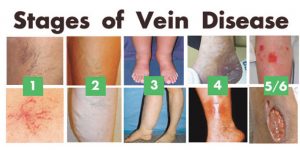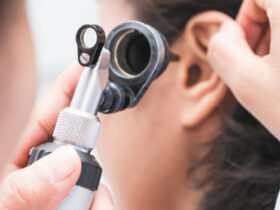By Dr. Lackey
 Millions of people have varicose vein problems, yet only one half of 1 percent seek treatment. Vein disease goes undiagnosed and therefore undertreated. Patients tell us that their physicians have reassured them that the leg symptoms they experience are a part of aging and that it is “nothing to worry about.” Ignoring daily leg swelling, pain, cramping, leg heaviness, fatigue, itching, and discoloration can lead to permanent changes. Vein disease is progressive, meaning it will worsen at a rate of 4 percent every year. This article will discuss the other complications that can lead to serious problems including bleeding, swelling, phlebitis, cellulitis, blood clots, and skin ulcers.
Millions of people have varicose vein problems, yet only one half of 1 percent seek treatment. Vein disease goes undiagnosed and therefore undertreated. Patients tell us that their physicians have reassured them that the leg symptoms they experience are a part of aging and that it is “nothing to worry about.” Ignoring daily leg swelling, pain, cramping, leg heaviness, fatigue, itching, and discoloration can lead to permanent changes. Vein disease is progressive, meaning it will worsen at a rate of 4 percent every year. This article will discuss the other complications that can lead to serious problems including bleeding, swelling, phlebitis, cellulitis, blood clots, and skin ulcers.
Skin Changes
Chronic venous insufficiency (CVI) can cause skin changes resulting in discoloration of the lower legs, which is known as hyperpigmentation. It appears as a darkening of the skin often with a rusty-orange color. Stasis dermatitis is inflammation of the skin caused by damage to vein close to the skin’s surface. This can appear as a red, violet, or brown rash between the ankle and the knee. Stasis dermatitis is a precursor for the development of cellulitis. Cellulitis is an infection of the skin caused by bacteria. Bacteria normally are present on the skin, but when injured, the bacteria can spread and grow beneath the surface which is made much worse by poor blood flow in the legs or feet. Cellulitis is treated with antibiotics.
Phlebitis
Thrombophlebitis, a blood clot in a superficial vein, is a common complication of varicose veins. This occurs because the dilated vein makes it easier to injure but can often occur without trauma. It presents as a hot, tender, thickened area along the length of the vein. It is very painful and associated with fever and fatigue. If phlebitis extends far enough up the leg it can cause a clot in the deep veins, which is a risk for pulmonary embolism, which can be fatal.
Bleeding
Bleeding from large varicosities is typically from a bump or scrape to the area. Many elderly people with thin-walled veins are at increased risk and may be completely unaware of a vein rupture until they see blood running down their legs or feel faint from blood loss. Bleeding can be life-threatening if unrecognized. If caught early, it can be controlled with leg elevation and compression. Repeated bleeding can occur in the same area until proper treatment of vein disease is performed.
Swelling
Vein disease causes swelling in the ankles and lower legs which appears worse after a day of standing. In advanced disease the swelling can be present all the time.
Typically, just above the ankle is where the swelling begins. If left untreated, this can worsen to lymphedema which is more
difficult to manage and treat.
Skin Ulcers
One of the most challenging vein complications is a skin ulcer. This is an open sore resulting from trauma to the skin. Trauma and chronic vein disease results in skin breakdown where the area around the open sore becomes red, swollen, tender, and painful. These ulcers typically occur on the inner side of the ankle. Patients are often frustrated by these ulcers as they are frequently sent for lifelong wound care with multiple dressing changes for a wound that never seems to heal. Unless the root cause of the ulcer, vein disease, is treated, the ulcers will recur in under 2 years. Vein treatment involving ablation and sclerotherapy can help these chronic ulcers to heal.
Blood Clots
A study published by the Journal of American Medical Association suggests that the presence of varicose veins may significantly increase the risk of deep vein thrombosis (DVT), which is better known as blood clots. These can be life-threatening if they travel to the lungs or hearts. Some DVTs may not have any symptoms, but most cause dramatic pain, swelling, and warmth of the leg. Left untreated, people with extensive DVTs are at a higher risk of developing pulmonary embolism where a clot can break away and travel to the lungs where, it can be deadly.
Florida Lakes Vein Center offers convenient appointments in our Lakewood Ranch office Tuesday – Thursday 8a.m. – 5p.m. and Friday 8a.m. – 3p.m. Call 941.866.8989 to schedule your free vein screening.
941-777-7771
19790 Wellen Park Blvd., Ste 201B
Venice, FL 34293
941-257-0765
1217 Jacaranda Blvd.,
Venice, FL 34292
941-866-8989
9114 Town Center Pkwy, Ste 101,
Lakewood Ranch, FL 34202








